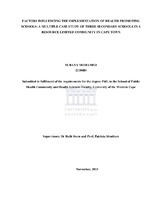| dc.description.abstract | Introduction: This study was conducted because of a gap in information on the factors influencing the health promoting schools (HPS) implementation process in South Africa (SA) specifically and in secondary schools globally. The aim of this context- sensitive, practice-based study was to explore and understand the complexity of the factors that influenced the implementation process of HPS in three secondary schools in a resource-limited setting in Cape Town, SA. This research drew on a five year project that initiated the implementation of HPS in these schools. Methodology: An exploratory qualitative study was used, adopting a multiple case study design. The sample included two principals, ten teachers and 30 students involved in HPS implementation at their schools, and the three school facilitators, who served as mentors to the schools. The data collection methods included: individual interviews, focus group discussions, documentary review, secondary data and observations. A conceptual framework was developed drawing on the settings approach and various implementation frameworks and was used to analyse the findings. Thematic analysis was employed and the data for each case were analysed separately first before undertaking cross case analysis. Findings: A combination of several internal and external factors influenced the ability of the schools to implement and integrate HPS as a whole school approach. A key factor was the degree of understanding of the HPS concept by all key actors and where there was lucid understanding, there was better integration. Significant school factors included the schools’ readiness for change; a culture of collaboration and cooperation; existing school structures, practices and workload; the leadership style and management role of the principals; the role and influence of HPS champion teachers; and the role that students played. The major external factors included the role of the education district; the role of project team as external catalysts for change; and the community context. The main achievements in all schools were discrete activities, including co-curricular activities rather than changes to routine school functions. This highlighted the difficulty in implementing HPS as a whole school approach, a challenge typical of all health promoting settings. Conclusion: The findings illustrate the challenge of achieving full integration of HPS, although the influencing factors, and hence level of integration varied mainly according to context. This highlights the complexity of the different factors and their impact. The study demonstrates the paradox of HPS implementation. In that, despite the recognition of the value of HPS, the challenges to address the complexity of factors that would have brought about change through a whole school approach were too great. It was too difficult to change the status quo from what was routinely done to a more radical way of working due to the conservatism of traditional ways of working and extent of adjustment that it would have resulted. It was therefore only possible to put simple, discrete, strategies in place and that was not too resource intensive. The study concluded that this does not imply that HPS should not be attempted, particularly where there are adverse conditions that would benefit from HPS. Starting with marginal changes, it can be effective in increasing the schools’ readiness for change, building on the achievements both in activities and structures, and the resultant commitment by those involved. Once they experience these changes it will more likely enable schools to incrementally attempt more complex changes. The key recommendations for within the school include: building the understanding and capacity of relevant actors to actively support the implementation of HPS; building the capacity of the principal to create an environment which is conducive to change; and providing support for the HPS champions and students. Recommendations for those external to the school include: support from external catalysts who can provide expertise and mentorship; support from the education district, especially in terms of policies on integration, resources, and raising the profile of HPS; and better collaboration between the education and health sectors. Although most of the literature on HPS implementation identifies similar issues to those found in this study, the complexity has not, to date, been sufficiently described. The contribution of this study, therefore, is to take the debate on the complexity of the factors influencing HPS implementation forward. | en_US |

